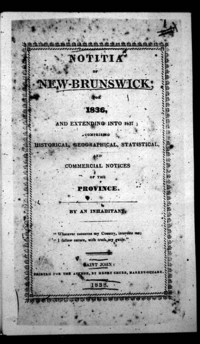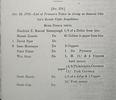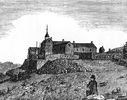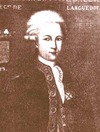
Source: Link
FISHER, PETER, merchant and historian; b. 9 June 1782 on Staten Island, N.Y.; d. 15 Aug. 1848 in Fredericton.
Peter Fisher is renowned as “the first historian of New Brunswick.” His two summary accounts of provincial life signalled the beginning of an indigenous literary tradition. The work of the son of a loyalist soldier and farmer, his sketches are particularly notable for the insights they allow into the values and aspirations of a second-generation, rank-and-file loyalist settler.
Although technically not a native of New Brunswick, Fisher spent all but the first 15 months of his life in the province, and his career was entirely shaped by its history and material circumstances. He was born in the final days of the American revolution in the British-held territory of Staten Island. He was the third child of Lewis Fisher, a member since 1776 of the New Jersey Volunteers, and his wife Mary Barbra Till, of whom little is known except that she was probably of English parentage. Lewis Fisher was of Dutch origin, and variations on the spelling of his first name include Ludovic, Ludwig, and Lodewick. Like so many of the Dutch settlers in America, he consistently supported the continuation of British rule in the colonies. He was taken prisoner for a time early in the war and then served in and around New York City. In company with many of his comrades, Fisher and his young family left New York in September 1783 on the Esther and sailed northward to begin a new life of exile in the Saint John River valley.
The family settled at St Anne’s Point on lands set aside for the loyalist military regiments. This community would soon be renamed Fredericton and transformed into the capital of the new province of New Brunswick, but in 1783 the site was a cold, forbidding wilderness. An invaluable narrative account of the first year of settlement, based on the recollections of Peter Fisher’s mother, was drawn up in the late 19th century by William Odber Raymond* from a document in the Fisher family’s possession; it provides a graphic picture of the hardships of the first winter. The loyalist families lived in tents, with stones for fireplaces and no flooring to separate them from the ground. “Many women and children, and some of the men, died from cold and exposure.” The survivors lived in “Indian fashion” off the natural bounty of the land and the river: “The men caught fish and hunted moose when they could. In the spring we made maple sugar. We ate fiddle heads, grapes and even the leaves of trees to allay the pangs of hunger.” The arrival of provision boats in the spring blunted the sharpest needs but the task of building shelters, clearing lands, and planting crops condemned the settlers to a continuing life of hard work and minimal nourishment: “For years there were no teams. . . . In the winter time our people had sometimes to haul their provisions by hand fifty or a hundred miles over the ice or through the woods. In summer they came in slow sailing vessels.” Although virtually nothing specific is known about Peter Fisher’s early life, this gruelling and dangerous settlement experience clearly dominated his childhood and shaped his outlook. His writings are marked by heartfelt tributes to the loyalist founders of New Brunswick who “wore out their lives in toil and poverty, and by their unremitting exertions subdued the wilderness, and covered the face of the country with habitations, villages, and towns.”
Living in Fredericton had its advantages none the less. A basic education was available and the stirrings of government stimulated an interest in the broader issues of provincial development. Fisher’s teacher was Bealing Stephen Williams, an English schoolmaster and former navy clerk, who taught school in Fredericton for nearly 40 years. Fisher acquired skill in reading, writing, and mathematics as well as a keen, methodical interest in the natural world and human history. On 15 Aug. 1807 the Anglican minister George Pidgeon married Fisher and Susannah Stephens Williams, the daughter most probably of Fisher’s mentor. Seven sons and four daughters were to be born to the Fishers, several of whom would make outstanding contributions to the public life of New Brunswick. As for Peter Fisher himself, disappointingly little is known about his active life. He is mentioned in several accounts as a prominent lumber merchant, and occasionally as a blacksmith and a general merchant. He doubtless also farmed, in the classic dual occupational pattern of the day. He was acclaimed by contemporaries as an omnivorous reader and a tireless walker, qualities which help to account for his remarkably specific familiarity with New Brunswick’s various regions. In 1892 Senator John Glasier* reminisced about a youthful trip with Fisher which revealed the author’s purposefulness. “In 1829 I had a remarkable trip up river along with the late Peter Fisher and a sturdy negro named Jacques. We took a sailing vessel up the reach [Long Reach], and made the balance of the journey on foot, across the Devil’s Back and on through to Oromoncto, which place we reached that night. We only had a loaf of bread and a quart of milk in the way of food for the three of us, and we walked from eight in the morning till ten at night. I was pretty foot sore when we arrived at Oromoncto, but Mr. Fisher was fresh and wanted to push on to Fredericton after supper. And Mr. Fisher was then nearly sixty years of age. He obtained a pint of rum, part of which he shared with me, but the liquor did not agree with me. Mr. Fisher used the balance of the rum to bathe his leg and foot. When I awoke in the morning they told me that the old man was on his way to Fredericton. I was then in my twentieth year.”
Substantive knowledge of Fisher comes only from his writings, which reveal a man of moderate literary skills, keen powers of observation, and intense interest in the progressive, orderly development of New Brunswick. His first known work, with its long full title, Sketches of New-Brunswick; containing an account of the first settlement of the province, with a brief description of the country, climate, productions, inhabitants, government, rivers, towns, settlements, public institutions, trade, revenue, population, &c., was published anonymously “By an Inhabitant of the Province” in 1825 and was printed on the Saint John press of Henry Chubb* and James Sears. According to an advertisement in the Royal Gazette of 10 Feb. 1824, Fisher had published an earlier, simpler version of this work for children, entitled The Fredericton primer; it included reading and spelling exercises, as well as a geography and brief history of the province. No copy of this primer has been identified by modern scholars. Fisher’s second extant work is both a revision and an enlargement of the first, Notitia of New-Brunswick, for 1836, and extending into 1837; comprising historical, geographical, statistical, and commercial notices of the province, and appeared anonymously in 1838; it too was printed by Chubb. Fisher’s unwillingness to claim authorship led to considerable confusion: in the 19th century the Notitia was sometimes attributed to Alexander Wedderburn rather than Fisher. In the 20th century Fisher has occasionally been credited with a third work, The lay of the wilderness . . . (Saint John, 1833), an epic poem about the loyalist period. Internal evidence suggests, however, that Fisher could not have written this poem, and scholars now conclude that only the two histories – the Sketches and the Notitia – should be attributed to him.
The preface to the Sketches states that the aim of the author is “to diffuse a general knowledge of the Country” as precisely and impartially as its newness and inadequate records will allow. Fisher writes in the spirit of the Enlightenment, with its ideal of scientific knowledge and its concern for social betterment. His work is essentially a catalogue of the physical and human characteristics of New Brunswick. He describes and ranks everything: climate, topography, crops, fish and game, trees and minerals, forms of government, churches and their memberships, ethnic peoples and their ways of life, cities and their activities, imports, exports, architecture, schools, degrees of capital investment, natural phenomena such as fires, freshets, and earthquakes, as well as the moral character of the inhabitants. Much of the Sketches reads like a technical report, with an abundance of factual detail alleviated only occasionally by a spare descriptive phrase singling out a “noble river” or the “sublime and terrific appearance” of a waterfall.
Yet Fisher was not a mere gatherer of facts. His text is punctuated with clear statements of goals and sharply critical comments, both of which spring from his deep commitment to the development of his province. He is thus an ardent patriot but never a boastful one. His ideal for New Brunswick centres around the loyalist vision of an agrarian society based on a substantial yeomanry and supplemented by a thriving timber trade and growing commercial and industrial sectors. Like the founders, Fisher believes that an agricultural way of life will not only provide material self-sufficiency but also ensure order, respect for property, and personal independence. In the Sketches, Fisher assesses all provincial peoples, activities, and institutions with reference to their functional contribution to this ideal. The original loyalist leaders and the “paternal” first governor, Thomas Carleton*, are praised for introducing sound principles of settlement into “a desolate wilderness.” Religious and ethnic groups are ranked, with a painstaking effort at objectivity, in terms of their social impact. Fisher singles out the English immigrants from Yorkshire and their descendants as “the most thriving class of settlers,” whose practices of careful cultivation and husbandry have yielded abundant crops and superior cattle. He also admires the internal peace and self-sufficiency of the Acadian people, acknowledging that they are “a different race from the English” – “very lively and hospitable, but very slovenly in their houses and cookery” – and worthy of praise as quiet, constructive members of the New Brunswick community. By contrast Fisher expresses distress over the failure of both black and Indian inhabitants to become useful settlers. He is alert to the cultural origins of their difficulties and remarkably sensitive to the “bold and figurative” Indian languages, but he pessimistically predicts that failure to adapt to the settlement pattern will condemn both groups to decline and dependence. Throughout the text, Fisher’s clear ideal is the pioneer backwoodsman, “a man with his axe and a few other simple tools . . . [who] feels perfectly at home in the depth of the forest” and who can supply his wants through his own exertions. With fervent, lyrical emphasis, Fisher argues that “the genius of these people differ[s] greatly from Europeans – the human mind in new countries left to itself exerts its full energy.” The experience of coping successfully in the wilderness fosters “ideas of self-importance and independence” and “much native freedom in their manners . . . [which] from their veneration to their King makes them faithful subjects and good citizens, not blindly passive, but from affection adhering to that Government under which they drew their first breath.”
If pioneer resourcefulness constitutes the basis of Fisher’s greatest hopes for New Brunswick, his deepest apprehensions are triggered by the excesses of the timber trade. Fisher’s experience as a lumber merchant makes his comments especially noteworthy. He is unsparing in his criticism of the way in which the temptation to speculate in lumber has wasted the wealth of the forest and produced a dissipated mode of living. The source of the trouble in his view is the activity of alien speculators, who originally came from the United States to exploit the forest. Although new regulations in 1825 limited the granting of timber licences to British subjects, they did nothing in Fisher’s view to halt the plunder of the woods by outside profit-seekers. These adventurers “have taken no interest in the welfare of the country; but have merely occupied a spot to make what they could in the shortest possible time.” In particular northeastern New Brunswick has by no means reaped its just reward from its vast timber resources: “The wealth that has come into it, has passed as through a thoroughfare to the United States . . . . the forests are stripped and nothing left in prospect,” neither large towns nor improved roads nor the kind of splendid and spacious public buildings which “speak much, though silently, for the public spirit, taste, and importance of a country.”
Despite these reservations, the portrait of New Brunswick that emerges from the Sketches is buoyantly optimistic. The vigour and health of its people can combine, Fisher is sure, to tap the riches above and below the ground and produce a flourishing trade and civilized communities. He acknowledges that much is still to be done in his young province and lays down thoughtful, practical suggestions on the most essential needs: accurate data on climate and soil to improve agriculture, a pool of capital investment and cheap labour to augment trade and explore mineral wealth, better roads and a canal for communication, and more splendid architecture for public edification. Above all, the crown lands must be reorganized to tie the development of timber resources to the permanent settlers who feel their interest identified with the country. The colony’s deficiencies do not diminish Fisher’s pride in New Brunswick. He rejoices particularly that “the state of learning in this Province is very flourishing” and that, between the College of New Brunswick at Fredericton and the various parish, grammar, and Madras schools, education “is brought to the doors of most of the inhabitants, who will exert themselves to partake of the public benefit.”
Taken as a whole, this first history provides a vivid insight into the social philosophy and mentality of a rank-and-file loyalist descendant. There is every reason to assume that Fisher’s ideals of social progress, orderly development, and personal independence were widely held in New Brunswick, and that this energetic commitment to provincial betterment accounts in no small measure for the prosperity which was achieved in the 1820s and sustained for the next three decades.
Fisher’s second edition of his history, the Notitia of New-Brunswick, published in 1838, affords an opportunity to re-examine this mentality and note its development. Although the Notitia reiterates most of the data published in the original Sketches, the prose is more concise and the style more colourful. Equally noticeable is a change in tone. Ten years of prosperity and unprecedented cultural achievement have produced a more boastful, aggressive, and romantic response from Fisher. He boldly asserts that “in few parts of the United States do the people live as well, and perhaps in no country has the labourer better wages, or the enterprising genius a wider field for exertion.” He enumerates the sources of wealth in far more confident terms and especially notes the construction of fine houses and commercial establishments in Saint John and the introduction of such organizations devoted to “pleasing arts” as floral and horticultural societies. Two social changes in particular command Fisher’s attention. The first is the influx into the province of vast numbers of Irish immigrants who are, he notes, assimilating well and who will likely make Roman Catholicism the majority religion in New Brunswick in the near future. The other significant change is the establishment of King’s College by royal charter in 1829. Fisher describes the curriculum of this institution with immense pride, taking particular note of the fact that no formal restrictions are placed on students respecting age, religion, or prior education.
A new, strident political note also appears in the Notitia. The timber regulations for the crown lands have been redefined to Fisher’s satisfaction by 1837. Payment in full was now required for purchases of crown lands, a provision that favoured the local settler and ended irresponsible speculation. However, the political abuses that gave rise to “alien speculators” remain unresolved and provoke Fisher into severe criticism of the military lieutenant governor, Sir Archibald Campbell, the arbitrary powers of his Executive Council, and above all the extravagant emoluments of the commissioner of crown lands, Thomas Baillie*, and his father-in-law, Provincial Secretary William Franklin Odell. Here again Fisher is mirroring public disgust at the powers of the small “family compact” in Fredericton who used the freedom from public control afforded by their imperial appointments to encourage capitalistic exploitation of provincial resources. Although he could not know it, Fisher was writing at the very moment when a delegation from the New Brunswick House of Assembly was reaching an accord with the British government which not only settled this vexed issue but also made New Brunswick the first of the British North American colonies to achieve democratic reform, all public revenues and the membership of the Executive Council being made subject to the will of the elected representatives of the people. Fisher’s sentiments were squarely on the side of popular rule but equally firm in support of the British connection, thus accurately reflecting the long-standing loyalist ambivalence between the democratic assumptions brought up from America and the historic commitment to an imperial, hierarchical structure. History does not record Fisher’s opinions on the momentous changes that occurred after 1837, but it is significant that his son Charles Fisher* led the movement for responsible government in New Brunswick and later played a key role in bringing the loyalist province into confederation.
Fisher’s first wife had died in 1836 and on 30 Nov. 1847, shortly before his own death, he was remarried, to Mrs Mary Valentine of Saint John. In addition to the public contribution of his son Charles, his son Henry briefly succeeded Joseph Marshall* de Brett Maréchal as superintendent of education for New Brunswick, his son William served as the Indian superintendent for some years, and his son Lewis Peter became a prominent lawyer and educational philanthropist. A daughter, Ann, married Charles Connell*, a member of the first Dominion parliament, and a granddaughter, Annie Connell Fisher, was the wife of George Robert Parkin*, the noted educator and prophet of imperialism. Thus for three generations and beyond, the Fisher family represented the backbone of the loyalist movement, the middle ranks of hard-working, self-confident settlers and citizens whose belief in progress and popular government was always framed within the context of loyalty to the empire and peaceful, moderate change.
Fisher’s two contributions to New Brunswick history will always have a distinctive place as the first comprehensive reports on the state of the province by a permanent resident. They strike the 20th-century reader more as compendiums of factual material than as works of history, but they conformed to contemporary standards, which emphasized the systematic collection of past and present data fused with an assessment of the material accomplishments of human settlement. Fisher’s works lack the range and subtlety of Thomas Chandler Haliburton*’s classic account An historical and statistical account of Nova-Scotia (2v., Halifax, 1829), although the two authors shared a common concern for precise factual detail and a profound commitment to civilized life. Among the works of early New Brunswick historians, however, his Sketches rank above the efforts of Robert Cooney* and Moses Henry Perley* in terms of accuracy and critical balance. Only with the publication in London of Abraham Gesner*’s New Brunswick, with notes for emigrants . . . in 1847 does a fuller, more complex portrait of the province emerge. Fittingly, Gesner built on Fisher’s works and acknowledged the value of his pioneer contribution. Subsequent historians continue to do so.
A limited amount of personal material on Peter Fisher and his loyalist forebears is to be found at the PANB in church records and in the probate records (RG 7, RS75) and land petitions (RG 10, RS108) for York County; a search of the timber files for the period, however, yielded no data on his business activities. His Sketches were republished verbatim, with notes by William Odber Raymond, in Saint John, N.B., in 1921 under the title The first history of New Brunswick; this work was reprinted in Woodstock, N.B., in 1980. On Fisher’s supposed authorship of the epic poem, see The lay of the wilderness by a native of New-Brunswick, ed. T. B. Vincent (Kingston, Ont., 1982).
Robert Cooney, A compendious history of the northern part of the province of New Brunswick and of the district of Gaspé, in Lower Canada (Halifax, 1832; repub. Chatham, N.B., 1896). M. H. Perley, A hand book of information for emigrants to New-Brunswick (Saint John, 1854). New-Brunswick Courier, 4 Dec. 1847. Royal Gazette (Fredericton), 10 Feb. 1824, 23 Aug. 1848. Hill, Old Burying Ground. M. W. Barkley, “The loyalist tradition in New Brunswick: a study in the growth and evolution of an historical myth, 1825–1914” (ma thesis, Queen’s Univ., Kingston, 1972). Lawrence, Judges of N.B. (Stockton and Raymond). K. F. C. MacNaughton, The development of the theory and practice of education in New Brunswick, 1784–1900: a study in historical background, ed. A. G. Bailey (Fredericton, 1947). M. B. Taylor, “The writing of English-Canadian history in the nineteenth century” (phd, 2v., Univ. of Toronto, 1984), 1: 68. W. O. Raymond, “Peter Fisher, the first historian of New Brunswick,” N.B. Hist. Soc., Coll., 4 (1919–28), no. 10: 5–56. St. John Weekly Sun (Saint John), 31 Aug. 1892.
© 1988–2024 University of Toronto/Université Laval
Image Gallery




Cite This Article
Ann Gorman Condon, “FISHER, PETER,” in Dictionary of Canadian Biography, vol. 7, University of Toronto/Université Laval, 2003–, accessed April 26, 2024, http://www.biographi.ca/en/bio/fisher_peter_7E.html.
The citation above shows the format for footnotes and endnotes according to the Chicago manual of style (16th edition). Information to be used in other citation formats:
| Permalink: | http://www.biographi.ca/en/bio/fisher_peter_7E.html |
| Author of Article: | Ann Gorman Condon |
| Title of Article: | FISHER, PETER |
| Publication Name: | Dictionary of Canadian Biography, vol. 7 |
| Publisher: | University of Toronto/Université Laval |
| Year of publication: | 1988 |
| Year of revision: | 1988 |
| Access Date: | April 26, 2024 |

















